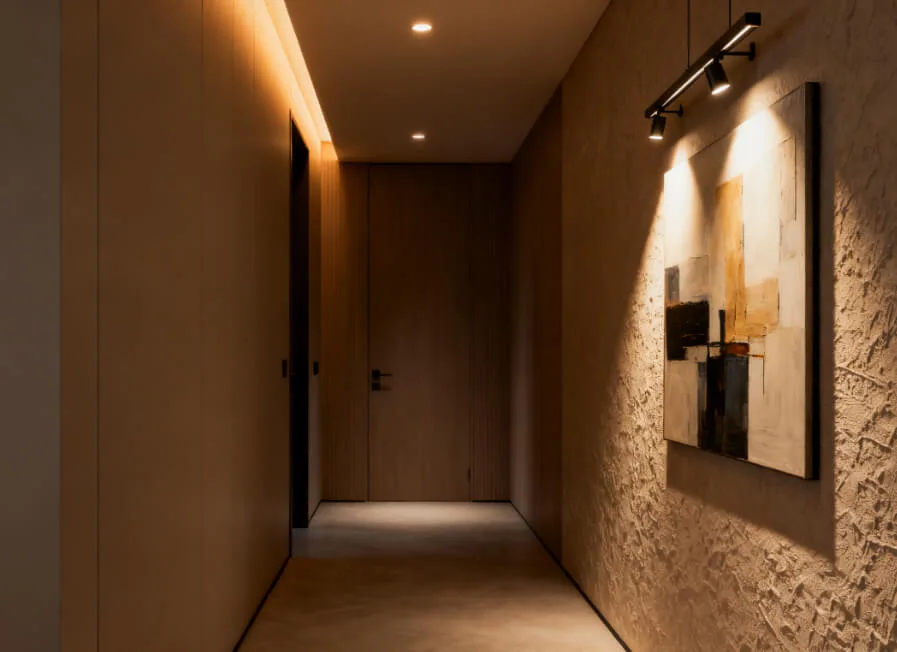When designing offices, shopping malls, or home environments, we focus on aesthetics, comfort, and general lighting. But have you ever wondered how people can evacuate safely when a sudden power outage plunges everything into darkness? This is when a seemingly ordinary yet crucial device—downlights with emergency power—becomes the true “light of life.”
It is not just a lighting tool but also a life safety device mandated by modern building safety regulations. Today, let’s delve into why installing such lighting is so important.
1. Beyond Illumination: The Core Line of Defense for Life Safety
In emergencies such as fires, earthquakes, or other disasters, the main power grid is likely to be cut off. Panic and darkness amplify the catastrophe.
-
Guiding orderly evacuation: Emergency downlights can automatically switch to battery power within 0.5 seconds, providing continuous illumination for over 90 minutes. They clearly light up escape routes, stairways, and exits, effectively preventing stampedes and collisions caused by poor visibility.
-
Supporting rescue operations: Reliable lighting provides crucial support for firefighters to quickly locate the source of a fire and search for trapped individuals, enhancing rescue efficiency in a race against time.
Keywords: Emergency lighting, life safety, evacuation guidance, fire emergency
2. More Than a Suggestion: Mandatory Regulatory and Compliance Requirements
In China, according to national standards such as the “Code for Fire Protection Design of Buildings” (GB50016), almost all public spaces are required to install compliant emergency lighting systems.
-
Scope of application: Crowded places such as shopping malls, hotels, office buildings, schools, hospitals, cinemas, and underground parking garages.
-
Inspection threshold: Fire safety acceptance is a mandatory prerequisite for building occupancy. Without a qualified emergency lighting system, the project cannot pass inspection.
-
Clear standards: Regulations specify detailed requirements for illuminance, duration, and installation locations (e.g., evacuation routes, safety exits).
Neglecting this not only endangers lives but also poses significant legal and economic risks.
Keywords: Fire regulation GB50016, fire safety acceptance, emergency lighting standards, mandatory requirements
3. Perfect Fusion of Aesthetics and Function: Why Choose Emergency Downlights?
What advantages do integrated emergency downlights offer compared to traditional externally mounted emergency lights?
-
Visual discretion: Recessed installation seamlessly blends with decorative ceilings, preserving the integrity and modern feel of the design without the eyesore of “patchwork” emergency lights.
-
More even illumination: As part of the basic lighting, their distribution is more scientific, providing shadow-free, uniform light during emergencies instead of harsh shadows from a single source.
-
Smart automation: The entire process requires no manual operation. They function as ordinary lights daily, automatically switch during power outages, and reset and recharge once power is restored, offering intelligent convenience.
Keywords: Recessed emergency lights, aesthetic lighting design, smart emergency lighting
4. How to Choose Reliable Emergency Downlights for Your Project?
With a mixed market of products, making the right choice is crucial.
-
Look for certification: The primary requirement is to check whether the product has CCCF certification issued by the National Fire Electronic Product Quality Supervision and Inspection Center. This is its compliance “ID card.”
-
Focus on core components:
-
Light source: Opt for LEDs for high efficiency and low power consumption, ensuring longer emergency operation.
-
Battery: Lithium batteries are the mainstream choice, offering long lifespan, light weight, and no memory effect, far outperforming older nickel-cadmium batteries.
-
-
Consider key parameters: Pay attention to emergency duration (≥90 minutes), switching time (<0.5 seconds), and initial illuminance (meeting regulatory lux requirements).
-
Choose a reliable brand: Select reputable brands with good service to ensure product quality and ongoing technical support and maintenance.
Keywords: CCCF certification, LED emergency light source, lithium battery emergency power, emergency lighting parameters
5. Don’t Forget: Maintenance Is Key to Sustaining Vitality
Even the best equipment requires upkeep. A common misconception is to “install and forget.”
-
Regular testing: Conduct monthly simulated power outage tests (usually via a test button on the panel) to ensure proper functionality.
-
Regular replacement: Emergency batteries typically last 3-4 years. Even if unused daily, they must be professionally replaced upon expiration; otherwise, the emergency function will fail.
Conclusion
Investing in downlights with emergency power is far more than a simple construction material purchase—it is a significant responsibility and guarantee for the safety of everyone in the building. Hidden silently in the ceiling, they transform into beacons guiding the way to survival in the most critical moments.
When planning your next project, do not view emergency lighting as a cost item but as an indispensable core safety investment. Because safety is always the bottom line of design.



